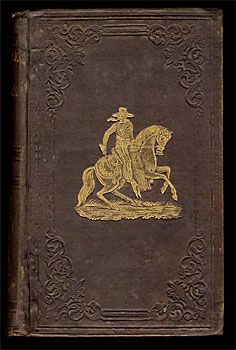| book art
Judging a Book by Its Cover
Gold-Stamped Publishers' Bindings of the 19th Century
Bookbinding was one of the last of the bookmaking processes to be mechanized. Since the invention of printing by movable type in the fifteenth century, books had been issued in folded-and-gathered printed sheets—often in paper wrappers—which the buyer then had bound to order. In the early nineteenth century, the development of case binding, a technique conducive to mass production, at last made possible the manufacture of books with uniform edition bindings.
The advent of gold-stamped decoration, circa 1832, was the most important factor in the acceptance of publishers' bindings. Gold stamping brought to the mass-produced book some of the prestige associated with gold-tooled leather bindings of the pre-industrial era. In fact, stamping often imitated the decorative styles and motifs of the hand-finished book. However, gold stamping also developed its own styles and imagery that reflected the period' s taste and culture.

[more]
thanks to BookLab II |

